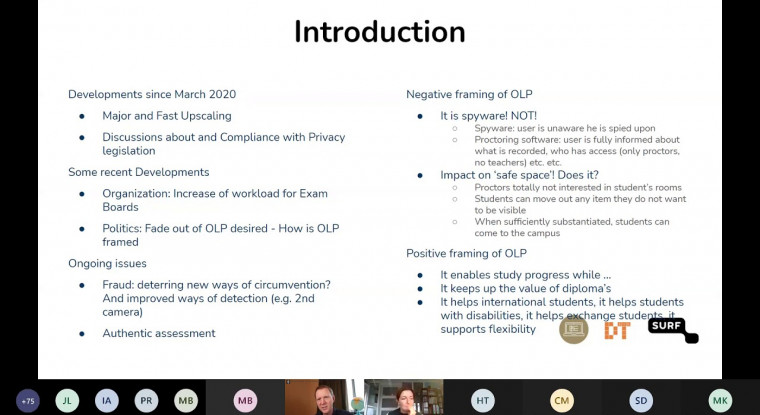Nina Reimert
Communicatieadviseur en Content manager Meer over Nina Reimert
Since the lockdown in March 2020 we have seen an enormous growth in the number of digital exams. Online proctoring in particular has been subject to a lot of discussion. The impact on the privacy of students is the main concern. During corona the lawful basis is quite simple. We have to ensure study progress. But what are the post-corona scenario’s and possibilities for online proctoring? That was the subject of the webinar Online proctoring for the future, last Monday December 14.

If you want to talk about any-time-any-place assessment there are two things we need to tackle, says Sharon Klinkenberg (Chair SIG Digital Assessment and Chair Focus Group Digital Assessment at the University of Amsterdam).
The first one is the right framing of online proctoring. Talking about online proctoring you often hear comments like ‘it’s spyware’ and ‘it impacts the safe space of students’. Is that really true? Proctoring software does not spy on students, they are fully informed and it’s covered in privacy statements. And does it impact the safe space? Students can move out things they do not want to be visible and when sufficiently substantiated they always have the option to come to the campus.
Second one to tackle is the technical development of the software to prevent fraud. For example, looking at new ways of circumvention and improved ways of detection. Higher education institutions should make crystal clear to the software suppliers what their requirements for privacy are.
So, what are the future scenario’s for online proctoring? During the webinar Silvester Draaijer (Program manager Network for Teaching and Learning at the VU Amsterdam) explained the main considerations in order to choose a path for the future.
What will happen post corona? Will we all go back to the campus and stop using online proctoring? Or will there be a smart implementation of online proctoring for the future? The three main considerations are:
Since corona the number of digital tests has increased 150 – 200 percent. Pre corona you would book a room at the campus for a digital test. We should realise that post corona the capacity at our institutions will not be sufficient due to this enormous growth. So anyhow, we have to think of a solution for this capacity issue.
Costs consists of infrastructural and processing costs. When using online proctoring a reduce in infrastructural costs is likely. This is because less computers are needed (students bring their own), less physical exam space is needed (maybe about 50% of the students will take the exam at home) and less live proctors are needed.
Processing costs are expected to remain the same. The review time is less, but the costs for the exam boards will increase. Overall, using online proctoring could save us costs is Silvesters conclusion.
The third consideration is the lawful basis for the use of online proctoring. Currently, during corona this is ‘Legitimate interest’. To ensure study progress. This argument is more complicated for the after-corona era. Students can go to the campus to take an exam. Other arguments for using online proctoring could be: it’s cost effective, there is an increased demand and the impact on privacy is not that big if there are no recordings from the students home situation.
Let’s look at a possible smart implementation of online proctoring with ‘legitimate interest’ as lawful basis. How could that be done?
For example: Let students take exams on their own device and let them choose where they want to take the test. At home with proctoring or at the campus with proctoring. In this case institutions should have: a true Bring Your Own Device policy in place, keep a close eye on the prevention of fraud, stimulate further development on the software side and have systems in place that make the scheduling and logistic part possible.
A challenge will be to estimate how many students will choose to come to the campus. A recent evaluation at the Vrije Universiteit showed that about 50% of the students would prefer an exam from home. Will this hold after corona? And will this be the same for every exam? Some responses in the chat during the webinar showed that this number is recognisable for other institutions.
At the Eindhoven University of Technology they recently did a pilot on hybrid testing. Manager Teacher Support & Quality Assurance Education and Students Affairs Ludo van Meeuwen is positive about the first results. In the pilot students can choose upfront whether to take the exam at the campus or at home. In the last test 50% of the students choose on campus and 50% at home. The hybrid setup turned out to be very flexible. Due to corona measures they lastminute had to do the entire test at home. The switch was rather easy because that part was well prepared as well. In the future a hybrid setup could really lower the pressure on the campus capacity.
Of course there are challenges. For example, do the test outcomes differ between students at home and students on campus? This is something we will closely analyse Ludo says. Based on the first tests in the summer there are no indications for differences yet. Another issue the pilot uncovered, is with the breaks. Students at home take a short break after 90 minutes. But on campus this is not possible. It would be a lot of crowd to manage. Especially during corona this is not desirable. The solution for now is that students complete and hand in part A, take a break and after that continue with part B.
Overall Ludo sees opportunities for online proctoring post corona. Yes, there are fraud issues to tackle. Let’s really hope the software undergoes the needed development. From an organisational point of view it is well possible. And you could also see the hybrid form as a service to your students. They get to choose the option that suits them best.
In authentic assessment you approach the working field as much as possible. Sharon Klinkenberg mentions the example in Radiology where students go through 3D images and get questions on specific parts of these images. Really like they would do in their future job. Special software is needed for these kinds of assessments and at the University of Amsterdam special exam halls are equipped for this. The capacity is under pressure though. Authentic assessment is becoming more popular, so new solutions are being discovered.
How can you do authentic assessment on students’ own devices? Sharon thinks a virtual desktop in order for all students to have the right software is desirable. During the corona crisis they have seen students struggling with problems like not being able to install the right software, software not working or not having the right version. This causes a lot of struggle and stress, which you want to avoid. Therefore the special interest group has investigated possibilities to take exams via BYOD, where software is provided via VM-ware in the cloud. SURF, together with the SIG, developed a proof of concept for this. In the beginning of 2021 the SIG will share these experiences with a broader audience.
Volg de SIG Digitaal Toetsen op de SURF Communities. Houd ook de Werkgroep Toetsen op Afstand van het Versnellingsplan onderwijs met ICT in de gaten.
Via de Vraagbaak Online Onderwijs blijf je op de hoogte van alle actuele publicaties op het gebied van online onderwijs. Volg de vraagbaak ook op LinkedIn.
Communicatieadviseur en Content manager Meer over Nina Reimert



0 Praat mee